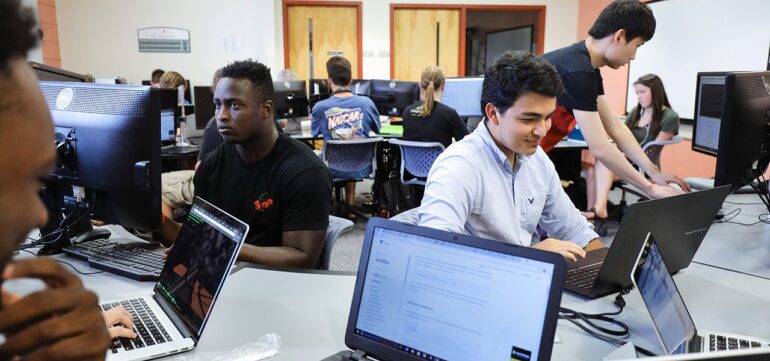TL;DR:
- Computing courses are witnessing a surge in popularity among school-leavers, driven by the rise of digital technology and AI.
- Applications for computing programs have increased by nearly 10% compared to the previous year.
- Despite the growth, computing education ranks as the seventh most popular area of study, with business, management, and arts courses attracting higher application numbers.
- Fields such as medicine, social sciences, biological and sports sciences, and engineering and technology are more popular than computing.
- Software engineering and computer science programs experienced the most significant increase in applications this year.
- The growing interest in computing courses may be influenced by the increased public conversation surrounding technology and AI.
- Access to programming knowledge through platforms like YouTube and ChatGPT has contributed to students’ ability to explore computing at their own pace.
- Computing-related employment opportunities are expanding, particularly in AI, data science, software design, and computing technologies.
- While the number of applications from students from disadvantaged backgrounds has increased, computing education remains male-dominated.
- The overall number of UK 18-year-old applicants remains high, indicating strong demand for higher education opportunities.
Main AI News:
The allure of artificial intelligence (AI) and digital advancements has sparked a remarkable upswing in the number of school-leavers opting for computing courses, according to the Universities and Colleges Admissions Service (UCAS). The latest application data reveals that 18-year-olds are increasingly captivated by the prospect of studying computing, thanks to the exponential rise of digital technology and AI. UCAS chief executive Clare Marchant acknowledged the surge, stating that applications for computing courses have surged by nearly 10% compared to the previous year.
While the growth in applications is significant, computing education still ranks as the seventh most popular area of study in higher education. Although nearly 95,000 students applied for computer and AI-related courses, the number pales in comparison to the applications received for business and management programs, which amounted to almost double that figure. Similarly, design, creative and performing arts courses garnered over 125,000 applications. Fields such as medicine, social sciences, biological and sports sciences, as well as engineering and technology, also enjoyed more popularity than computing.
Nevertheless, UCAS highlights that the number of applicants for computer-related courses has experienced consecutive growth since 2019. The current year has witnessed a substantial surge in applications for software engineering, which rose by 16% compared to the previous year. Additionally, computer science programs attracted 11% more applicants, while there was a 2% rise in students pursuing computer games and animation and a 4% increase in those interested in artificial intelligence.
The heightened interest in computing education may be attributed, at least in part, to the burgeoning public discourse surrounding technology and AI, suggested Ms. Marchant. Drawing parallels to the increased demand for economics courses following the financial crisis of 2008, as well as the surge in applications for medicine and nursing during the Covid-19 pandemic, she emphasized the correlation between changes in society and the demand for certain educational programs.
Chris Derrick, deputy headteacher at Kelvinside Academy in Glasgow, shared insights on the current crop of students applying for computing courses. He described them as “digital natives” who have honed their skills from an early age through daily engagement with powerful technology. Derrick also highlighted the accessibility of programming knowledge via platforms like YouTube and ChatGPT, enabling pupils to explore their passions and learn at their own pace with the assistance of search engines and online tutorials.
While much of the recent public discourse has revolved around job displacement caused by AI, there is also a burgeoning array of employment opportunities emerging in AI, data science, software design, and computing technologies. UCAS further noted an increase in applications from 18-year-olds from disadvantaged backgrounds, indicating a positive shift in accessibility and inclusivity.
However, the field of computing remains predominantly male-dominated, with female students comprising only 18% of applications for computer-related studies. Although this percentage has seen a slight increase from 17% in 2022 and 16% in 2021, there is still progress to be made in achieving gender parity within the discipline.
Despite these challenges, the total number of applications from UK 18-year-olds reached over 319,500, the second-highest figure recorded, albeit slightly lower than the previous year. Rashik Parmar, chief executive of BCS, The Chartered Institute for IT, underscored that the surge in demand for computing degrees among British teenagers is unsurprising, given their awareness of the transformative impact AI will have on the world. Vanessa Wilson from the University Alliance echoed this sentiment, suggesting that the increased popularity of computing education may be attributed to rising awareness of technologies such as AI, coupled with students’ strong desire to cultivate future-proof skills.
Conclusion:
The surge in students pursuing computing education driven by the AI trend signifies the increasing recognition of the role technology plays in our lives. As more individuals recognize the potential and relevance of computing skills, it presents a significant market opportunity. Educational institutions, technology companies, and industry stakeholders should seize this momentum to develop innovative programs, bridge the gender gap, and cater to the rising demand for skilled professionals in areas such as AI, data science, software design, and computing technologies. By addressing the growing interest and ensuring inclusivity, the market can leverage the enthusiasm of aspiring students and meet the evolving needs of the digital era.

